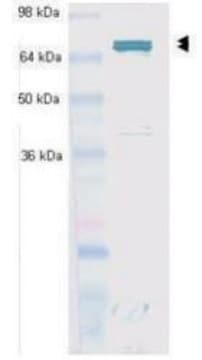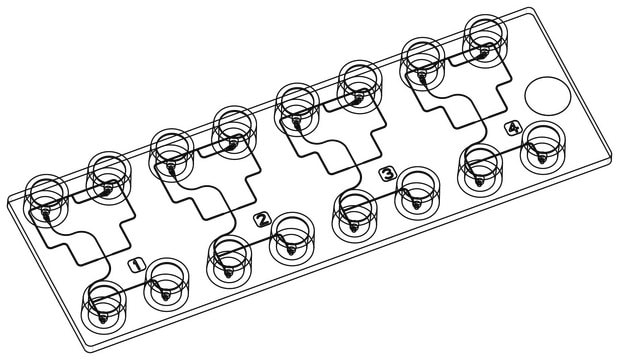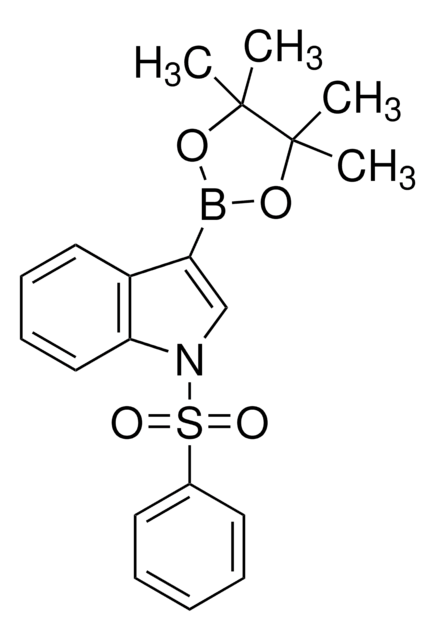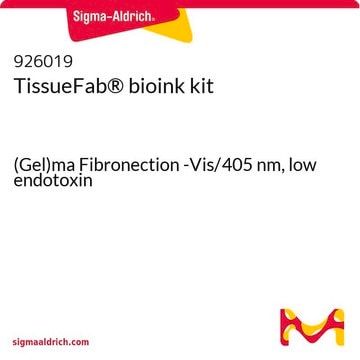推荐产品
尺寸
10 mL
品質等級
描述
Application: 3D bioprinting
Sterility: 0.2 μm filtered
形狀
viscous liquid (to gel)
雜質
<5 CFU/g Bioburden (Fungal)
<5 CFU/g Bioburden (total aerobic)
<50 EU/mL Endotoxin
顏色
pale yellow to colorless
儲存溫度
2-8°C
正在寻找类似产品? 访问 产品对比指南
一般說明
TissueFab® bioink -(GelHep)MA Vis/405 nm, low endotoxin formulation can be used to bioprint cell-laden hydrogels in the desired shape without any supporting material. This bioink can be crosslinked in one step using exposure to 405 nm light for further culture and maturation of cells for tissue engineering and regenerative medicine applications.
About the material:
Heparin is a naturally occurring linear biopolymer and highly sulfated glycosaminoglycan (GAG). Research has demonstrated that heparin can modulate binding extracellular matrix proteins and sequester growth factors and cytokines, making them useful in 3D applications. The methacrylate-functionalization of heparin allows thermal or photochemical crosslinking via covalent conjugation. Heparins exhibit high anionic charge densities to promote large swelling ratios in water. Heparin-based bioinks are used in tissue engineering, 3D bio-printing, and drug delivery applications.
Gelatin methacryloyl (GelMA) is a polymerizable hydrogel material derived from natural extracellular matrix (ECM) components. Due to its low cost, abundance, and retention of natural cell binding motifs, gelatin has become a highly sought material for tissue engineering applications. The addition of photocrosslinkable methacrylamide functional groups in GelMA allows the synthesis of biocompatible, biodegradable, and non-immunogenic hydrogels that are stable in biologically relevant conditions and promote cell adhesion, spreading, and proliferation.
Low Endotoxin, low bioburden: Endotoxins can negatively impact cellular growth, morphology, differentiation, inflammation, and protein expression. The bioburden is the number of contaminated organisms found in a given amount of material.
We test each lot for endotoxins in addition to total bioburden (aerobic and fungal) to minimize unwanted interactions. For more information:
Cell Culture FAQs: Bacterial Endotoxin Contamination
About the material:
Heparin is a naturally occurring linear biopolymer and highly sulfated glycosaminoglycan (GAG). Research has demonstrated that heparin can modulate binding extracellular matrix proteins and sequester growth factors and cytokines, making them useful in 3D applications. The methacrylate-functionalization of heparin allows thermal or photochemical crosslinking via covalent conjugation. Heparins exhibit high anionic charge densities to promote large swelling ratios in water. Heparin-based bioinks are used in tissue engineering, 3D bio-printing, and drug delivery applications.
Gelatin methacryloyl (GelMA) is a polymerizable hydrogel material derived from natural extracellular matrix (ECM) components. Due to its low cost, abundance, and retention of natural cell binding motifs, gelatin has become a highly sought material for tissue engineering applications. The addition of photocrosslinkable methacrylamide functional groups in GelMA allows the synthesis of biocompatible, biodegradable, and non-immunogenic hydrogels that are stable in biologically relevant conditions and promote cell adhesion, spreading, and proliferation.
Low Endotoxin, low bioburden: Endotoxins can negatively impact cellular growth, morphology, differentiation, inflammation, and protein expression. The bioburden is the number of contaminated organisms found in a given amount of material.
We test each lot for endotoxins in addition to total bioburden (aerobic and fungal) to minimize unwanted interactions. For more information:
Cell Culture FAQs: Bacterial Endotoxin Contamination
應用
Currently, there is a need for high-quality, commercially available ready-to-use bioink formulations to enable the reproducible fabrication of synthetic tissues and organs by 3D Bioprinting
- drug discovery
- in-vitro disease models
- regenerative medicine
- cell-cultured meat
特點和優勢
- Bioprinting models replicate biology for drug discovery and in vivo applications
- Sterile, low endotoxin
- Batch control offers reproducible models for preclinical toxicology testing and drug screening
- Extended shelf-life & stability
其他說明
Rethink your Bioinks with TissueFab
- Ready-to-use formulations eliminate the lengthy bioink formulation development process
- Provide an optimized microenvironment conducive to the growth, proliferation, and maturation of cells
- Validated with widely used cell types (including hMSCs) used in 3D Bioprinting
- Step-by-step protocols developed and tested by internal R&D 3D Bioprinting Scientists
- Compatible with different extrusion-based 3D bioprinter models
法律資訊
TISSUEFAB is a registered trademark of Merck KGaA, Darmstadt, Germany
儲存類別代碼
12 - Non Combustible Liquids
水污染物質分類(WGK)
WGK 3
閃點(°F)
Not applicable
閃點(°C)
Not applicable
Cailing Zhao et al.
Biomacromolecules, 22(6), 2729-2739 (2021-06-01)
Extrusion-based bioprinting is an emerging and most frequently used technique for the fabrication of cell-laden constructs. A suitable hydrogel-based bioink for cell encapsulation and protection is critical for printability, structural stability, and post-printing cell viability. The thiol-ene chemistry-based gelatin-norbornene (GelNB)
Liliang Ouyang et al.
Science advances, 6(38) (2020-09-20)
A major challenge in three-dimensional (3D) bioprinting is the limited number of bioinks that fulfill the physicochemical requirements of printing while also providing a desirable environment for encapsulated cells. Here, we address this limitation by temporarily stabilizing bioinks with a
Danielle S W Benoit et al.
Biomaterials, 28(1), 66-77 (2006-09-12)
Poly(ethylene glycol) (PEG) hydrogels functionalized with heparin were utilized as a three-dimensional culture system for human mesenchymal stem cells (hMSCs). Heparin-functionalized hydrogels supported hMSC viability, as quantified through live/dead imaging, and induced osteogenic differentiation, as measured by increased alkaline phosphatase
Oju Jeon et al.
Journal of controlled release : official journal of the Controlled Release Society, 154(3), 258-266 (2011-07-13)
Photocrosslinkable biomaterials are promising for tissue engineering applications due to their capacity to be injected and form hydrogels in situ in a minimally invasive manner. Our group recently reported on the development of photocrosslinked alginate hydrogels with controlled biodegradation rates
Yingkai Liang et al.
Acta biomaterialia, 10(4), 1588-1600 (2013-08-06)
Heparin plays an important role in many biological processes via its interaction with various proteins, and hydrogels and nanoparticles comprising heparin exhibit attractive properties, such as anticoagulant activity, growth factor binding, and antiangiogenic and apoptotic effects, making them great candidates
我们的科学家团队拥有各种研究领域经验,包括生命科学、材料科学、化学合成、色谱、分析及许多其他领域.
联系技术服务部门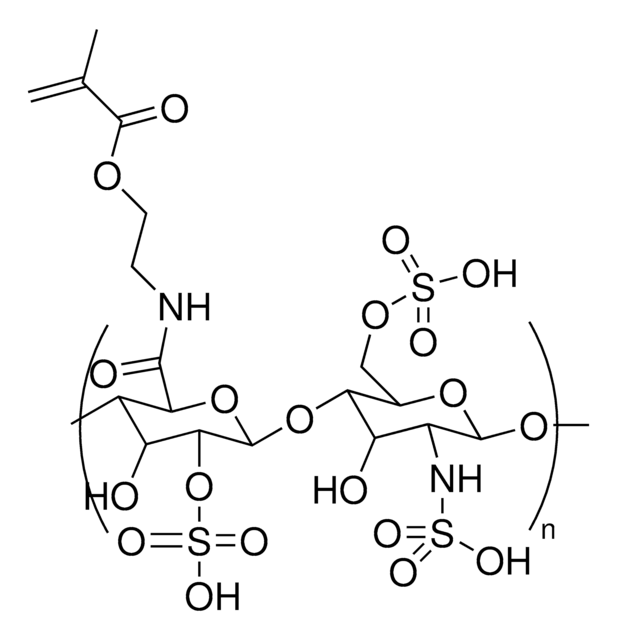
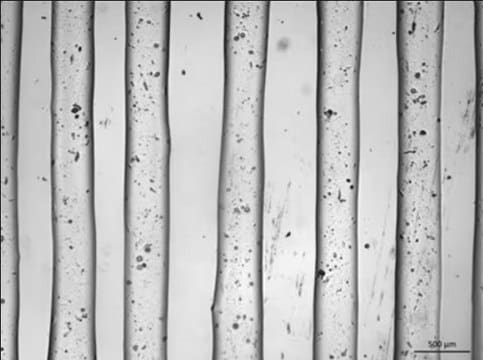
![[Ir(df(CF3)ppy)2(4,4′-(OMe)2bpy]BF4 ≥95%](/deepweb/assets/sigmaaldrich/product/structures/294/662/6528b9bf-e008-4b6e-ab53-daa85d4e1dcc/640/6528b9bf-e008-4b6e-ab53-daa85d4e1dcc.png)
